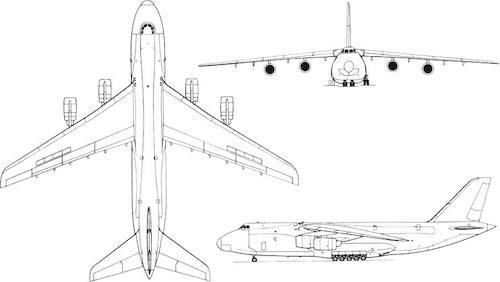An-124 Condor
Summary
| Category | Military Transport Aircraft |
| Origin country | 🇨🇳 Ex-USSR |
| Manufacturer | Antonov |
| First flight | 26 December 1982 |
| Year introduced | 1986 |
| Number produced | 55 units |
| Average unit price | $100 million |
Description
In response to a shortfall in heavy airlift capacity within the Military Transport Aviation Command of the Soviet Air Forces, design work commenced in 1971 at the Antonov Design Bureau on what was initially known as Izdeliye 400. The project, overseen by lead designer Viktor Tolmachev, produced a design that, while bearing resemblances to the American Lockheed C-5 Galaxy, incorporated improvements such as a greater use of carbon-fibre composites and titanium. In 1973, facilities for producing the An-124 were established at two separate plants: Aviastar-SP in Ulyanovsk, Russia, and the Kyiv Aviation Plant AVIANT in Ukraine, utilizing components from over 100 factories across the Eastern world. Assembly of the first aircraft began in 1979, and the An-124, sometimes referred to as the An-40 in the West, performed its maiden flight on 24 December 1982. The type made its first appearance in the Western world at the 1985 Paris Air Show. Following the dissolution of the Soviet Union, commercial operations were pursued, leading to civil certification on 30 December 1992, after which various operators acquired refurbished ex-military airlifters or stored fuselages.
The Antonov An-124 Ruslan shares external similarities with the American Lockheed C-5 Galaxy, featuring a double fuselage enabling a rear cargo door on the lower fuselage that can open mid-flight without affecting structural integrity. Flight control surfaces, like slats, flaps, and spoilers, mirror the C-5's layout. However, the An-124 has a slightly shorter fuselage, a slightly greater wingspan, and a 17 percent larger payload capacity. Instead of the C-5's T-tail, the An-124 has a conventional empennage, like the Boeing 747. The An-124 also features a fly-by-wire control system that incorporates conventional mechanical controls for redundancy against hydraulic circuit failure. It is powered by four Lotarev D-18 turbofan engines, each capable of generating up to 238–250 kN of thrust, and features thrust reversers. The landing gear has an oleo strut suspension system for its 24 wheels calibrated to allow for landing on rough terrain. Its cargo compartment measures 36×6.4×4.4 m and can carry up to 150 tonnes of cargo. The floor of the cargo deck is titanium, and is suitable for carrying almost any heavy vehicle, including multiple main battle tanks. An onboard overhead crane, capable of lifting up to 30 tonnes, further facilitates loading and unloading, with items up to 120 tonnes being winched on board. The upper deck can carry 88 passengers.
During the 2000s, the An-124 saw service in a NATO strategic airlift initiative led by Germany, with two aircraft leased from SALIS GmbH as a temporary measure pending the availability of the Airbus A400M. Under the NATO SALIS program, NAMSA chartered six An-124-100 aircraft from Antonov Airlines and Volga-Dnepr for cargo transport for 18 nations. Two An-124-100s were permanently based at Leipzig/Halle Airport, with additional aircraft available on short notice, proving crucial for NATO operations in Iraq and Afghanistan. Beyond military applications, United Launch Alliance (ULA) employs the An-124 to transport Atlas V launch vehicles and Centaur upper stages between manufacturing facilities and launch sites, requiring two flights per vehicle. Space Systems Loral and SpaceX also contracted the An-124 for satellite and payload fairing transport. By 2013, the An-124 had visited 768 airports in over 100 countries. In 2020, the remaining civil operators included Antonov Airlines, Volga-Dnepr Airlines, and Maximus Air Cargo, until Volga-Dnepr grounded its fleet following an uncontained engine failure; operations resumed later that year. The An-124 has also played a role in humanitarian efforts, including transporting the Obelisk of Axum back to Ethiopia in 2005, assisting with the Deepwater Horizon oil spill cleanup in 2010, delivering a concrete pump to Japan following the Fukushima nuclear accident in 2011, and airlifting military equipment during the 2021 German troop withdrawal from Afghanistan. During the COVID-19 pandemic, An-124s were deployed to transport medical equipment from China. However, in February 2022, one An-124 was destroyed by Russian artillery during the Battle of Antonov Airport, Kyiv, while others were diverted to Leipzig.
Main Variants:
-
An-124 Ruslan: The original strategic heavy airlift transport aircraft.
-
An-124-100: A commercial transport aircraft variant of the An-124.
-
An-124-100M-150: An upgraded version with a payload capacity increased to 150 tonnes and uprated Lotarev D-18T series 4 engines.
-
An-124-102 Slon: A commercial transport version featuring an EFIS (Electronic Flight Instrument System) flight deck.
-
An-124-115M: A planned new variant incorporating an EFIS based on Rockwell Collins avionics parts.
Technical specifications
| Version: An-124-100 | |
|---|---|
| Crew | 7 members |
| Operational range | 13,300 km (8,264 mi) |
| Maximum speed | 865 km/h (537 mph) |
| Wing area | 628 m² (6759.7 sqft) |
| Wingspan | 73.3 m (240.5 ft) |
| Height | 20.8 m (68.2 ft) |
| Length | 69.0 m (226.2 ft) |
| Service ceiling | 9,000 m (29,528 ft) |
| Empty weight | 175,000 kg (385,808 lbs) |
| Max. takeoff weight | 405,000 kg (892,871 lbs) |
| Takeoff distance | 2,800 m (9,186 ft) |
| Powerplant | 4 x turbojets Ivchenko-Progress D-18T delivering 23400 kgf each |
Current operating countries
| Country | Units | ||
|---|---|---|---|

|
Russia | 5 | |

